WHAT'S NEW ACROSS THE WORLD
Select date in side bar to go a What's
New of previous issues
| What's New ©by
Laif DeMason
With autumn now upon us, we hope that the extreme
weather of the summer of 2007 is now behind us. Many parts of the
world have endured long droughts, or excess rains and flooding, along with
the many destructive storms and hurricanes. These catastrophic events
not only affect us, but also animals in the wilds. Fish are no exception.
Excessive droughts or floods can wreak havoc on their natural populations.
Unusual weather events are not the only problem facing freshwater fish
populations. We all know man’s impacts are large, through exotic
introductions, deforestation, mining, as well as general human encroachment
which has devastated many freshwater fish populations, sometimes beyond
repair. It is really up to us to protect the species that exist now,
whether in their natural settings or in our home aquaria. Our future
unborn generations are watching!
Here’s “what’s new” on the cichlid scene: |
Lake Tanganyika
The normal ebb and flow of species popularity continues with Tanganyikan
cichlids. A few odd ‘oldies’ have once again appeared and have been
well received by hobbyists. Other recently popular varieties, such
as Petrochromis seem to be holding hobbyists’ interest. Goby cichlids
have also regained new popularity.
|
what's new: Lake Tanganyika
|
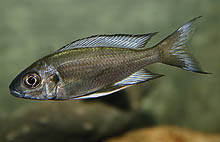
Exported many times from Burundi several years ago,
Opthalmotilapia heterodon is found in the northern end of the Lake.
This interesting fish is clearly different from the Op. ventralis
form in the south. Photo by T. Andersen. |
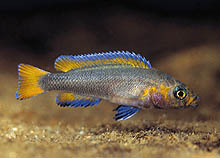
Neolamprologus sp. cyngus was bred regularly
some years ago before it disappeared from the supply lines. When
young, this fish sports a bright orange head. Photo by A. Konings. |
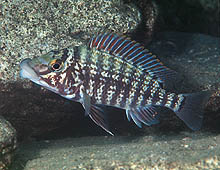
Lobochilotes labiates is found all around Lake
Tanganyika. However, juveniles are exported from Burundi by request
and have appeared on importers’ lists again. Photo by A. Konings. |
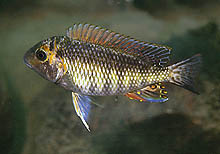
One of the many Petrochromis exported from
Zambia, P. sp. “orthognathus tricolor” from Chimba. This fish
is often sold as Petrochromis Tricolor. Photo by A. Konings. |
Lake Malawi
Small, captive raised, mbuna from Malawi are some of the most popular
fishes for many beginning aquarists. However, the next new trend
for the advanced Malawi fan is unclear. Some people seem to favor
very large colorful Malawi cichlids, whether haplochromines or mbuna.
Others still prefer the large Aulonocara ‘peacock’ forms.
Time will only tell which will be the next fashionable Malawi cichlids.

Often difficult to collect in shallow waters, Protomelas
sp. “spilonotus tanzania” from Njambe, Tanzania, is sometimes sold as “Insignus”.
This fish generally colors up well in captive conditions, even freshly-caught
individuals. |
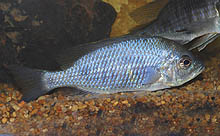
Several cichlids are exported seasonally from Tanzania.
There are a few confusing Nyassachromis species, this one is sold
as Nyassachromis Likoma Blue, but may really be N. sp. “interuptus”
Likoma. |
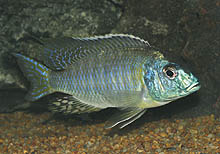
Only the more colorful Lethrinops species are
shipped from Lake Malawi. This one from Manda, Tanzania is sold as
Lethrinops Green Face and is often more than 5 inches in length. |
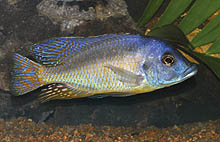
A few individuals of a very large but unknown species
arrived in the USA recently from Tanzania. This cichlid is perhaps Mylochromis
melanotaenia sporting strong coloration. |

Some of the predatory haplochromines are only caught
in small numbers. Here Hemitaeniochromis urotaenia, was imported
from Tanzania. Usually only six to eight individuals are available at any
given time. |

Originally sold from Malawi as OB Mbenji Special Zebra,
this Metriaclima mbenjii variety has been selectively bred in Florida
to bring out strong reddish hues. |
Lake Victoria
Great news for the Victorian cichlid enthusiast, and it has been a long
time coming! New collections of wild caught cichlids from Lake Victoria
proper have recently occurred. It has been nearly ten years since
new wild material has been available from this Lake. Many species
populations are now such that normal collections are possible. Of
course these are some of the most common species of years past, but it
is a start! We can only hope that these new shipments will be well
received and the exports will continue.
|
what's new: Lake Victoria
|
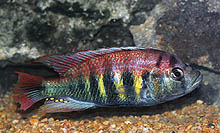
Reportedly caught on the western side of Mwanza Gulf,
this Pundamilia nyererei variety displays even brighter red hues
when interacting with other males. |
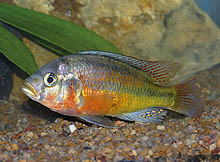
Territorial males Paralabidochromis sp. “rock
kribensis” from Tanzania turn bright red with black markings when displaying
to like individuals, losing the yellow-green hues.
|
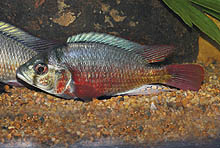
Another species recently shipped from the wild, Lithochromis
rufus (Red Pseudonigricans), is a rather large fish from Lake Victoria
with a deep body profile.
|
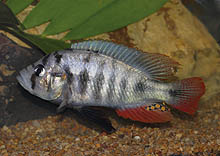
A second nyererei-like species recently imported,
Pundamilia pundamilia from Makobe Island. This fish sports scarlet
anal and caudal fins, and alternating gray and black irregular barring
on its flanks. |
Neotropics
Just when you think you have seen it all before, new and very unusual
cichlids appear from (this time) the New World. It goes to show you
that cichlid fauna still holds treasures in many unexplored corners of
the world. Will we find more novelties before their habitats are
destroyed forever?
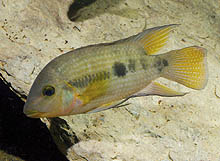
Exported in small numbers now from southern Brazil,
Australoheros tembe has arrived of late. This rheophile cichlid
can be quite aggressive in an aquarium. Photo by O. Luncanus. |
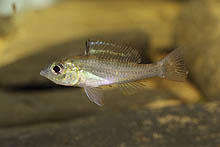
Collected near the city of Santarem on the Rio Tapajos,
Brazil, Biotoecus opercularis is a delicate dwarf cichlid.
At first glance, one would not expect this fish to be from the New World.
Photo by O. Lucanus. |
Select date in side bar to go a What's
New of previous issues
|















